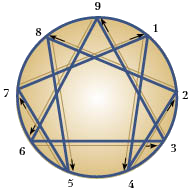The Enneagram is a dynamic model of human development based on nine distinctly different ways of viewing the world. These ways are reflected in our thoughts, feelings and behaviors, which come together to comprise what we call our personality. As children we tried out different strategies to feel safe and secure in the world. But one of these was a much better fit between our environment and our temperament than the others, and soon it was hard-wired into our structure. Personality helps us express who we are, relate to others, make predictions about what will happen next, and it reveals where we focus our attention. When an individual is determining which of these personality styles reflects his or her way of being in the world, it is from examining core motivation, not just ways of seeming or behaving. Type is identified from within, not from the outside.
All nine strategies are successful and we experience them all to some degree. They all fit quite naturally into the range of human experience. But the one we lean on determines how we feel about ourselves and how we interact with others at home, socially and at work. Our chosen perspective is rooted in basic beliefs about the world and our role in it. Through studying the Enneagram we can come face to face with what these beliefs are, as reflected in our thoughts, feelings and behaviors. We can notice where they are useful to us and where they are out-dated. We begin to see our defenses and coping strategies up close, how they serve us and how they hinder us.
We use the word "dynamic" to describe the Enneagram because, like personality, it is in motion. The arrows on the diagram describe the shifts in personality under stress and at times of security. This accounting for change in personality is significant and answers questions about why people describe themselves as acting different ways at different times. For instance, certain people become more anxious under stress, others more depressed, others become efficient problem-solvers. This is all accounted for in this elegant diagram. The study of the Enneagram with its balanced holding of all nine points of view, can lead to new levels of awareness and acceptance of self and others.
Attention
We cannot possibly focus our attention on everything at once. As our personality formed we learned to automatically pay attention to those things or events in the environment that support our fundamental beliefs about life, especially when we experience discomfort. As we train ourselves to notice where we automatically put our attention, we can see its limited, hypnotic nature. If we explore how our placement of attention helps or hinders us, we can start changing limiting patterns of decision-making, goal-setting, predicting and relating, Through observational skills and practice, we can allow the Enneagram to point us toward growth.
one | two | three | four | five | six | seven | eight | nine
